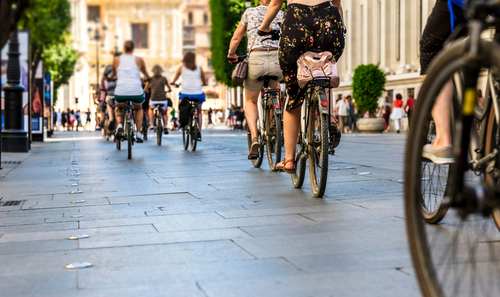Belgium (Brussels Morning Newspaper), Ahead of next month’s publication of the European Cycling Declaration, a new survey, which collected results from 29 cities, has shown that cities want “strong support” from the European institutions to develop “safe, high-quality infrastructure.” This, it says, includes cycling paths, segregated lanes, and bike parking spaces.
Cities polled outline their goal to increase the number of cycling trips in their local area. Nearly half of cities say their aim is to make trips made by bike represent at least 20% of the total number of journeys made in their area by 2030.
To achieve this goal, cities say targeted EU funding for cities is required, along with EU rules to protect the safety of cyclists, including reviews of local speed limits. They also stress the need for more EU research into technologies to collect cycling data, so cities can identify potential bike safety or parking issues.
“Cities want to seize the unprecedented opportunity of a European Cycling Declaration, using their years of experience to collaborate with European institutions to deliver a trail-blazing declaration that can revolutionize cycling and transform city living,” says André Sobczak, Secretary General of Eurocities.
“Cyclists produce 84% less carbon emissions than car drivers, yet on average in the EU only 7.4% of the total number of passenger trips are made by bike. An ambitious European Cycling Declaration will give city leaders the support they need to push forward with ground-breaking cycling initiatives that will get people out of cars and onto their bikes, improving their health, and reducing congestion and pollution.”
The Eurocities Pulse research is accompanied by a new policy statement, which stresses that the European cycling declaration must: • Build on the ambitious cycling policies that cities have already implemented. In Paris, annual cycling traffic has surged by 166% since 2018, due to 1,000km of new bike lanes.
• Support the development of a safe and high-quality bike infrastructure to encourage cycling in Europe. It should set minimum cycling quality levels, provide more funding options, and give local authorities flexibility when they need it.
• Ensure that cycling is safe, making the protection of cyclists a key goal. The EU should make it possible for cities in all EU member states to independently implement the 30km/h speed limit in cities and review national traffic rules to ensure they safeguard cyclists. 61% of cities said their streets are already subject to a 30km/hr speed limit, however, many cities are still unable to implement such measures due to national rules.
• Develop tools for collecting cycling data, including the number of bike trips being taken, the purposes of trips, or the types of bikes they are using, such as e-bikes or cargo bikes. This data will help cities develop actions to address barriers to cycling. Many cities do not collect this data, making it difficult for cities to address unsafe areas and bike parking needs.
• Make cycling more widely accessible to everyone, regardless of age, gender, ethnicity, location, or reduced mobility. This includes supporting people who cannot afford to buy a bike, or whose disability prevents them from using a two-wheeler. 39% of cities said that inclusion is part of their cycling strategy.
• Develop a strong, skilled and flourishing cycling industry that will create jobs and prevent bike shortages and long waiting lists for bike repairs.
• Improve connections between cities and their surrounding suburban and rural areas, by integrating cycling with multimodal transport systems, such as train journeys, buses, metros, and trams. This would mean having dedicated spaces for bikes in train stations or guaranteeing peoples’ right to carry bikes. ends



